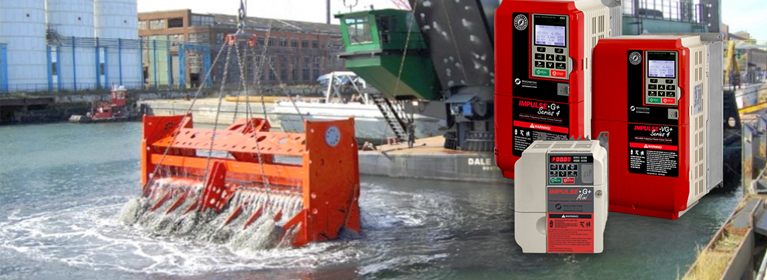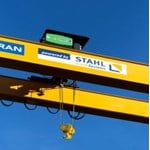
Choosing the Right VFD for Your Crane Application: Crane-Specific VFDs vs. General Purpose VFDs
Crane Systems | Power & Motion Technology | How To's | By Casey Cummins | May 07, 2021
When choosing a variable frequency drive (VFD) for your crane or hoist application, we recommend using a “crane- specific” VFD and not a general-purpose VFD. Why? Using a crane-specific VFD can have a significant impact on the safety, uptime, and productivity of your crane application, and can get you up and running quicker and easier. They are specially designed for the unique needs and situations encountered during crane operation. In other words, a fan, pump, or conveyer is dramatically different than an overhead crane or hoist. The forces of gravity and inertia impact these applications differently, and a crane-specific VFD will provide unique safety features and ensure seamless setup. Let’s take a closer look at the unique features of crane-specific VFDs.
specific” VFD and not a general-purpose VFD. Why? Using a crane-specific VFD can have a significant impact on the safety, uptime, and productivity of your crane application, and can get you up and running quicker and easier. They are specially designed for the unique needs and situations encountered during crane operation. In other words, a fan, pump, or conveyer is dramatically different than an overhead crane or hoist. The forces of gravity and inertia impact these applications differently, and a crane-specific VFD will provide unique safety features and ensure seamless setup. Let’s take a closer look at the unique features of crane-specific VFDs.
Built-In Safety Features Are Specifically Designed for Lifting and Positioning Loads
Crane-specific VFDs are designed with safety features specifically for lifting applications. Some of these include:
- Brake integrity check at the start and end of every lift
This feature minimizes the chance of a load falling to the floor due to a brake failure. If the VFD has detected that the brake is slipping or has failed, it will electrically hold the load and alert the operator to lower the load to the ground immediately. - Electrical integrity check throughout operation
Crane-specific VFDs monitor the health and performance of the motor and power supply. The VFD knows the safe limits for itself and the motor and will prevent overloading and overheating. If the line power loses a phase, sags, or induces excessive ripple, the VFD will stop to prevent operation in these unsafe situations. - Protect the crane from unsafe use by the operator
Crane-specific VFDs oversee what the operator is doing and attempt to prevent unsafe use. For example, travel limits can be set so the crane doesn’t collide with the wall or the hook doesn’t hit the floor. The VFDs also have an anti-shock feature that protects the crane from shock loading by the operator as well as a slack cable feature that protects the crane from excessive rope unwrap that could cause an overwrap of the drum when the load is lifted. Without a load cell, it may be unknown whether a load exceeds the safe capacity of the crane. The VFD takes the guesswork out of that situation and can be calibrated to a known maximum load.
VFD Settings Are Catered to Lifting Applications
General-purpose VFDs can be complicated, featuring numerous options that are not specific to crane applications. Safely configuring a general-purpose VFD to operate a crane can be time-intensive. For example, a certain setting may make the motor spin faster. While this may not be a concern for something like a fan, it can cause a safety issue on a hoist. Crane-specific VFDs have features that are easy to set up and incorporate logic that takes the forces and axis of lifting applications into consideration.
Specialty Features Improve Crane Productivity
Crane-specific VFDs are designed with special features you can’t find in a general-purpose VFD. These features make it easier and safer for workers to operate the crane, which in turn improves productivity. For example, an operator can transition between a creep speed or extended speed range with the flip of a switch. This decreases cycle time and improves positioning accuracy with minimal effort from the operator.
Looking specifically at productivity, these VFDs have motion capabilities that can be used to safely speed up lifting applications. They can control tasks that would be normally be controlled by an operator with features such as sway control, hoist synchronization, overload detection, and fine positioning control (micro-speed).
Wiring can be simplified with the use of industrial communications (e.g. Ethernet/IP) and Point I/O control schemes. These VFDs also make crane automation easy by using the available I/O and crane-specific features.
Unique Capabilities Increase Uptime
Because crane-specific VFDs are developed around information that is important to crane users, they provide diagnostic information critical to crane applications. The Magnetek Datalogger Series 4, for example, makes it easy to troubleshoot crane anomalies by recording valuable runtime data that pinpoints the exact time and events that lead to the crane failure.
Cranes are not always easily accessible, so you may need to take the crane out of production or climb up to the crane to troubleshoot or reprogram. Crane-specific VFDs make this easier. Many crane-specific VFDs communicate with PC software for easy VFD monitoring and management. This allows you to remotely monitor and access important crane information anywhere in your facility.
In addition to their unique features and capabilities, when you order a crane-specific VFD, you also have the added bonus of a team of crane experts ready to help you with your application needs. With a deep understanding of crane operation and controls, they’ll help ensure you fully take advantage of the VFDs’ extensive features and capabilities to increase your safety, uptime, and productivity.
Related Articles
Variable frequency drives, or VFDs, are a type of AC motor controller that drive an electric motor by varying the frequency and voltage supplied to it.
Overhead cranes are used everywhere. From automotive production facilities to power generation plants, cranes are used day in and day out to keep businesses running. To ensure the highest levels of safety and productivity, while meeting the changing demands of your business, it is important that your cranes are equipped with the latest technology, features, and capabilities.
To do this, you have a few options - buy a new crane, upgrade your existing crane, or repurpose another existing crane that may or may not fit the need. In many cases, it makes the most sense to upgrade your existing crane. Why? Older cranes were often over-engineered and built to last for several decades. When you buy a new crane today, it is hard to get the equivalent.

 North America - EN
North America - EN




